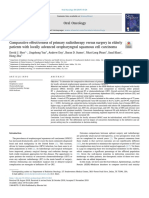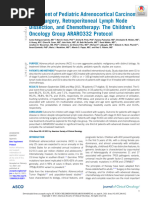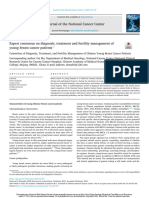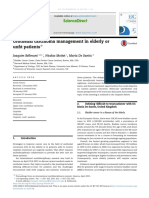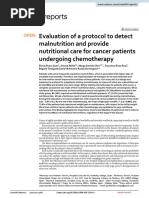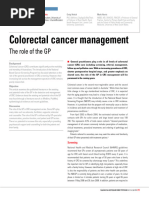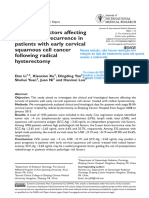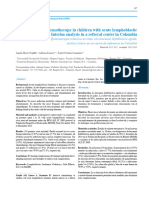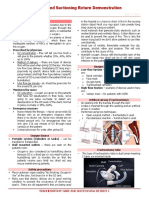0 ratings0% found this document useful (0 votes)
51 viewsDr. Kavuma Awusi Dr. Kanyike Daniel and Dr. Luutu Israel Radiotherapy Department Uganda Cancer Institute, P.O Box 3935 Kampala - Uganda
Dr. Kavuma Awusi Dr. Kanyike Daniel and Dr. Luutu Israel Radiotherapy Department Uganda Cancer Institute, P.O Box 3935 Kampala - Uganda
Uploaded by
SumantaThe study analyzed 304 pediatric cancer patients referred for radiotherapy in Uganda between 2015-2018. The most common cancers were Wilms tumor (23.4%), sarcomas (22.4%), and lymphomas (18.2%). Most patients presented with advanced disease (stages III-IV) and poor performance status. Only 61.3% were treated with radical intent while 34.2% received palliative care. Treatment outcomes were poor with only 67.7% completing the prescribed radiation doses and over half dead or lost to follow up within a year. The study highlights challenges with late stage presentation and limited diagnostic and treatment resources for pediatric cancer patients in low-resource settings.
Copyright:
© All Rights Reserved
Available Formats
Download as PDF, TXT or read online from Scribd
Dr. Kavuma Awusi Dr. Kanyike Daniel and Dr. Luutu Israel Radiotherapy Department Uganda Cancer Institute, P.O Box 3935 Kampala - Uganda
Dr. Kavuma Awusi Dr. Kanyike Daniel and Dr. Luutu Israel Radiotherapy Department Uganda Cancer Institute, P.O Box 3935 Kampala - Uganda
Uploaded by
Sumanta0 ratings0% found this document useful (0 votes)
51 views1 pageThe study analyzed 304 pediatric cancer patients referred for radiotherapy in Uganda between 2015-2018. The most common cancers were Wilms tumor (23.4%), sarcomas (22.4%), and lymphomas (18.2%). Most patients presented with advanced disease (stages III-IV) and poor performance status. Only 61.3% were treated with radical intent while 34.2% received palliative care. Treatment outcomes were poor with only 67.7% completing the prescribed radiation doses and over half dead or lost to follow up within a year. The study highlights challenges with late stage presentation and limited diagnostic and treatment resources for pediatric cancer patients in low-resource settings.
Original Title
7kavumaawusi
Copyright
© © All Rights Reserved
Available Formats
PDF, TXT or read online from Scribd
Share this document
Did you find this document useful?
Is this content inappropriate?
The study analyzed 304 pediatric cancer patients referred for radiotherapy in Uganda between 2015-2018. The most common cancers were Wilms tumor (23.4%), sarcomas (22.4%), and lymphomas (18.2%). Most patients presented with advanced disease (stages III-IV) and poor performance status. Only 61.3% were treated with radical intent while 34.2% received palliative care. Treatment outcomes were poor with only 67.7% completing the prescribed radiation doses and over half dead or lost to follow up within a year. The study highlights challenges with late stage presentation and limited diagnostic and treatment resources for pediatric cancer patients in low-resource settings.
Copyright:
© All Rights Reserved
Available Formats
Download as PDF, TXT or read online from Scribd
Download as pdf or txt
0 ratings0% found this document useful (0 votes)
51 views1 pageDr. Kavuma Awusi Dr. Kanyike Daniel and Dr. Luutu Israel Radiotherapy Department Uganda Cancer Institute, P.O Box 3935 Kampala - Uganda
Dr. Kavuma Awusi Dr. Kanyike Daniel and Dr. Luutu Israel Radiotherapy Department Uganda Cancer Institute, P.O Box 3935 Kampala - Uganda
Uploaded by
SumantaThe study analyzed 304 pediatric cancer patients referred for radiotherapy in Uganda between 2015-2018. The most common cancers were Wilms tumor (23.4%), sarcomas (22.4%), and lymphomas (18.2%). Most patients presented with advanced disease (stages III-IV) and poor performance status. Only 61.3% were treated with radical intent while 34.2% received palliative care. Treatment outcomes were poor with only 67.7% completing the prescribed radiation doses and over half dead or lost to follow up within a year. The study highlights challenges with late stage presentation and limited diagnostic and treatment resources for pediatric cancer patients in low-resource settings.
Copyright:
© All Rights Reserved
Available Formats
Download as PDF, TXT or read online from Scribd
Download as pdf or txt
You are on page 1of 1
The distribution and treatment outcomes of paediatric cancer patients referred for
radiotherapy in low and middle-income countries (LMIC) – The Uganda experience
Dr. Kavuma Awusi1, Dr. Kanyike Daniel1 and Dr. Luutu Israel1 1Radiotherapy Department Uganda Cancer Institute, P.O Box 3935 Kampala – Uganda
* Corresponding author: kavumawusi@yahoo.com
Figure 1: Distribution of Paediatric Cancers referred for Radiotherapy
• Background and Objective Results
• Cancer is one of the major causes of death for paediatrics and most paediatrics ❑ A total of 4178 patients were referred for RT, 304 (7.3%) were
die due to social economic factors e.g: poverty, limited treatment facilities, limited paediatrics. The M:F ratios was 1.2:1.
access to education / information, scattered rural populations, scarcity of ❑ Figure 1 show the distribution pattern of the cancers referred for RT
oncology experts, etc. ❑ Overall, the four most common cancers were Wilms (23.4%), Sarcomas
• LMIC have younger populations, proportion of children with cancer is (22.4%), Lymphomas (18.2%) and NPC (11.6%).
significant. ❑ 65.8% presented in ECOG status 0–1 and 34.2% in ECOG 2-3.
❑ Only 12% presented with stages I-II, the rest resented with stages III-IV.
• The burden of paediatric tumours in our radiotherapy resource-challenged
❑ 61.3% were planned & treated with radical intention.
center, is not well documented; hence the main objective of this study was to
❑ Wilms tumours presented mainly with stage III disease, post-surgery /
evaluate the distribution and treatment outcomes of paediatric tumours and to
chemotherapy and treated radically with 1.8 Gy daily doses for 6
propose strategies that could improve outcomes.
❑ The prescribed radical doses ranged from 36.0 Gy for lymphomas to
70.0Gy in extremity soft-tissue sarcomas.
❑ In 65% of the palliative treatments, single doses of 6.0Gy, 8.0Gy and
Methods 10.0Gy were prescribed; others were 20.0Gy/5 and 30 Gy/10.
o To evaluate the distribution and treatment outcomes of Paediatric ❑ Because large numbers presented relatively with advanced diseases and
cancers referred for Radiotherapy, we retrospectively reviewed all the in poor ECOG status, 67.7% completed the prescribed doses.
patient’s records/files referred to our department, from January 2015 ❑ For those who completed their treatments, their conditions at discharge
to December 2018. were 52.7% in ECOG 0-1, 25.8.7% in ECOG 2-3 and 21.5% in ECOG 4.
❑ After 6 months and one year of follow-ups, 47.7% and 56.8%
o The study involved patients aged 21 years and below with confirmed
respectively have been confirmed dead or lost to follow-up.
histological diagnosis referred for radiotherapy.
o The American Academy of Paediatrics categorises paediatric:
Discussion and Conclusions
▪ Infancy (birth-2), Childhood (2–12) & Adolescence (12–21) yrs of age
o Paediatric tumours comprised of a wide-range of cancers, accounting for ≈8% of all referrals and ≈90% present with advanced diseases and nearly
o Information retrieved from patients records/files included age, sex,
40% are treated palliatively which impedes on treatment outcomes.
histological diagnosis, stage, pre-treatment received, ECOG status,
o Precise diagnosis including pathology and imaging procedures to identify the stage - the foundation on which all subsequent management decisions
treatment intent, radiation dosages (fractionation/total-dose) and are based is not readily available in most rural areas.
follow-up at 3, 6 and 12months o One radiotherapy facility with long waiting times also resulted in some patients giving-up or failing to complete treatment. Logistical problems like
transport/finances, cultural beliefs and alternative medicines, etc caused delayed referrals and presentations.
1. Cristina D. Stefan. Patterns of Distribution of Childhood Cancer in Africa . J.Trop.Pediatr 2015, 61, 165–173
References 2. Qureshi SS, et al. A cross-sectional study of the distribution of pediatric solid tumors at an Indian tertiary cancer center. Indian J Cancer 2018;55:55-60
You might also like
- Pews Charts 4 11 MonthsDocument2 pagesPews Charts 4 11 MonthsKiara RevalinaNo ratings yet
- Family DeclarationDocument5 pagesFamily DeclarationVanlal Muanpuia100% (1)
- 72 Formula BingjiDocument74 pages72 Formula Bingjishane kiely100% (1)
- 1 s2.0 S1879406818301875 MainDocument5 pages1 s2.0 S1879406818301875 Maincheatingw995No ratings yet
- NCCN Compliance For Breast CancerDocument1 pageNCCN Compliance For Breast Cancerrisang bagaskoroNo ratings yet
- Comparative Effectiveness of Primary Radiotherapy Versus Surgery in ElderlyDocument9 pagesComparative Effectiveness of Primary Radiotherapy Versus Surgery in ElderlyBárbara Meza LewisNo ratings yet
- Older Adults With Cancer and Their Caregivers - Current Landscape and Future Directions For Clinical CareDocument14 pagesOlder Adults With Cancer and Their Caregivers - Current Landscape and Future Directions For Clinical CareSybil LandrinNo ratings yet
- Pi Is 0959804910000079Document7 pagesPi Is 0959804910000079khudher99No ratings yet
- Go 21 00140Document10 pagesGo 21 00140Abdul HadiNo ratings yet
- Breast Cancer Chemotherapy in Pointe NoireDocument5 pagesBreast Cancer Chemotherapy in Pointe NoireScivision PublishersNo ratings yet
- Cancer de PancreasDocument12 pagesCancer de PancreasRuben RoaNo ratings yet
- Et Al 2020 Treatment Outcomes of Patients With Colorectal Cancer Enrolled in A Comprehensive Benefits Program of TheDocument12 pagesEt Al 2020 Treatment Outcomes of Patients With Colorectal Cancer Enrolled in A Comprehensive Benefits Program of The052591No ratings yet
- Arar0332 Jco 2021 DR RaulDocument14 pagesArar0332 Jco 2021 DR RaulLeonardo Müller RodriguesNo ratings yet
- Journal of Geriatric OncologyDocument9 pagesJournal of Geriatric Oncologymanuela gilNo ratings yet
- Cervical Cancer Epidemiological Clinical and Therapeutic Aspects at Pointe Noire (Congo Brazzaville)Document5 pagesCervical Cancer Epidemiological Clinical and Therapeutic Aspects at Pointe Noire (Congo Brazzaville)Scivision PublishersNo ratings yet
- Impact of Radiotherapy Delay Following Biopsy GBMDocument11 pagesImpact of Radiotherapy Delay Following Biopsy GBMmohammed isam al hajNo ratings yet
- Dr. Soma Rani Roy, MBBS, DCO, FCPS, FICO, MRCS, Dr. Fahmida Hoque, MBBS, Dco, Fico, MRCS and Prof. Dr. Munirujzaman Osmani, MBBS, Dco, MSCDocument5 pagesDr. Soma Rani Roy, MBBS, DCO, FCPS, FICO, MRCS, Dr. Fahmida Hoque, MBBS, Dco, Fico, MRCS and Prof. Dr. Munirujzaman Osmani, MBBS, Dco, MSCBOHR International Journal of Current Research in Optometry and Ophthalmology (BIJCROO)No ratings yet
- Clinical StudyDocument7 pagesClinical StudyTit fuckerNo ratings yet
- Imaging_across_the_Life_Span_Innovations_in_ImaginDocument21 pagesImaging_across_the_Life_Span_Innovations_in_Imaginbalaya1281No ratings yet
- Uganda - CervixDocument9 pagesUganda - CervixDaniel PalmeraNo ratings yet
- The Oncologist 2003 Weinstein 278 92Document15 pagesThe Oncologist 2003 Weinstein 278 92Josne J. PaezNo ratings yet
- Xing et al 2013Document12 pagesXing et al 2013wzeng193No ratings yet
- Myositis Abstract v5-TMDocument5 pagesMyositis Abstract v5-TMcaptainessliliNo ratings yet
- 10 1002@pbc 27697Document8 pages10 1002@pbc 27697Ravi JhaNo ratings yet
- Journal of The National Cancer Center: A R T I C L e I N F o A B S T R A C TDocument8 pagesJournal of The National Cancer Center: A R T I C L e I N F o A B S T R A C TCirugia SolcaNo ratings yet
- Lessons Learned Treating Retinoblastoma in Panama Childrens HospitalDocument3 pagesLessons Learned Treating Retinoblastoma in Panama Childrens HospitalScivision PublishersNo ratings yet
- Clinical Impact of External Radiotherapy in Non-Metastatic Esophageal Cancer According To Histopathological SubtypeDocument12 pagesClinical Impact of External Radiotherapy in Non-Metastatic Esophageal Cancer According To Histopathological SubtypesilviailieNo ratings yet
- Brazda 2010Document6 pagesBrazda 2010mod_naiveNo ratings yet
- 1 s2.0 S1359634916000045 Main PDFDocument20 pages1 s2.0 S1359634916000045 Main PDFCardio FK UMPNo ratings yet
- RT PediatricDocument9 pagesRT Pediatricfaza mawaddahNo ratings yet
- Prognostic Factors in Nasopharyngeal Carcinoma With Synchronous Liver Metastasis: A Retrospective Study For The Management of TreatmentDocument7 pagesPrognostic Factors in Nasopharyngeal Carcinoma With Synchronous Liver Metastasis: A Retrospective Study For The Management of TreatmentChairul Nurdin AzaliNo ratings yet
- Djaa 048Document17 pagesDjaa 048Satra Azmia HerlandaNo ratings yet
- Late-Breaking Abstracts For MASCC/AFSOS/ISOO Annual Meeting 2024Document3 pagesLate-Breaking Abstracts For MASCC/AFSOS/ISOO Annual Meeting 2024Luiza MachadoNo ratings yet
- EJGO2022054 Cervical CaDocument8 pagesEJGO2022054 Cervical CaRahmayantiYuliaNo ratings yet
- 10996-Article Text-21020-1-10-20170903Document6 pages10996-Article Text-21020-1-10-20170903ZohrahLiaqatNo ratings yet
- Health Care Services in ElderlyDocument21 pagesHealth Care Services in ElderlySafy AbouSamraNo ratings yet
- PALLIATIVE RadiationDocument13 pagesPALLIATIVE RadiationFeras OskanNo ratings yet
- NIH Public Access: Author ManuscriptDocument22 pagesNIH Public Access: Author ManuscriptHumberto QuimeNo ratings yet
- A Comparative Study On The Treatment of Cervical Carcinoma by Radiotherapy Alone vs. Radiotherapy WiDocument13 pagesA Comparative Study On The Treatment of Cervical Carcinoma by Radiotherapy Alone vs. Radiotherapy WiIJRASETPublicationsNo ratings yet
- Histopathological Description of Testis Carcinoma and Therapy in Patients at Dr. Hasan Sadikin General Hospital During 2017-2020 REV 31 - 08Document15 pagesHistopathological Description of Testis Carcinoma and Therapy in Patients at Dr. Hasan Sadikin General Hospital During 2017-2020 REV 31 - 08Titus RheinhardoNo ratings yet
- Complications of Thyroid Cancer Surgery in Pediatric Patients at A Tertiary Cancer CenterDocument8 pagesComplications of Thyroid Cancer Surgery in Pediatric Patients at A Tertiary Cancer CenterCirugia pediatrica CMN RAZA Cirugia pediatricaNo ratings yet
- moots2016Document7 pagesmoots2016limey78460No ratings yet
- Risk of Subsequent Primary Malignancies Among SurvDocument3 pagesRisk of Subsequent Primary Malignancies Among Survdrturabuddin786No ratings yet
- Medullary Thyroid Cancer in The Era of Tyrosine Kinase Inhibitors: To Treat or Not To Treat-And With Which Drug-Those Are The QuestionsDocument7 pagesMedullary Thyroid Cancer in The Era of Tyrosine Kinase Inhibitors: To Treat or Not To Treat-And With Which Drug-Those Are The QuestionsIulia JulyNo ratings yet
- Evaluating Nutritional Health in Cases of Head and Neck Cancer Receiving RadiotherapyDocument7 pagesEvaluating Nutritional Health in Cases of Head and Neck Cancer Receiving RadiotherapyInternational Journal of Innovative Science and Research TechnologyNo ratings yet
- Evaluasi Protokol Untuk DideteksiDocument8 pagesEvaluasi Protokol Untuk DideteksiSeptianNo ratings yet
- Apatinib 2020Document6 pagesApatinib 2020bijit.bharadwaj43No ratings yet
- Head NeckDocument8 pagesHead NeckerandolphsavageNo ratings yet
- Jgo 19 00367Document25 pagesJgo 19 00367fernando souzaNo ratings yet
- Reti No Blast OmaDocument10 pagesReti No Blast Omamenesesjeanet2No ratings yet
- Use of High-Dose Chemotherapy in Front-Line TherapDocument8 pagesUse of High-Dose Chemotherapy in Front-Line TherapSri Eka HandayaniNo ratings yet
- Critical Appraisal of Prognostic Study: A Prognostic Study of Patients With Cervical Cancer and HIV/ AIDS in Bangkok, ThailandDocument22 pagesCritical Appraisal of Prognostic Study: A Prognostic Study of Patients With Cervical Cancer and HIV/ AIDS in Bangkok, ThailandHappy Ary SatyaniNo ratings yet
- Journal of Surgical Oncology 2024 Janczewski Utilization and SurvivalDocument8 pagesJournal of Surgical Oncology 2024 Janczewski Utilization and SurvivalJaqueline CarvalhoNo ratings yet
- Influence of Remoteness of Residence On Timeliness of Diagnosis and Treatment of Oral Cavity and Oropharynx Cancer: A Retrospective Cohort StudyDocument10 pagesInfluence of Remoteness of Residence On Timeliness of Diagnosis and Treatment of Oral Cavity and Oropharynx Cancer: A Retrospective Cohort StudyVitória LeiteNo ratings yet
- MainDocument7 pagesMainJoseOgazNo ratings yet
- Nursing ProcessDocument10 pagesNursing ProcessBrandy SangurahNo ratings yet
- Colorectal Cancer MGMTDocument3 pagesColorectal Cancer MGMTgreatawsNo ratings yet
- Rare Childhood Cancer Burden in A Tertiary Care Hospital of Dhaka BangladeshDocument8 pagesRare Childhood Cancer Burden in A Tertiary Care Hospital of Dhaka BangladeshScivision PublishersNo ratings yet
- Prognostic Factors Affecting Survial and Recurrence in Patientes With Early Cervical Squamous Cell Cancer Following Radical HTDocument13 pagesPrognostic Factors Affecting Survial and Recurrence in Patientes With Early Cervical Squamous Cell Cancer Following Radical HTfernandallmagalhaesNo ratings yet
- BFM 2009 Colombia 0120-0011-Rfmun-64-03-00417Document9 pagesBFM 2009 Colombia 0120-0011-Rfmun-64-03-00417erickmattosNo ratings yet
- The Role of Radiotherapy in Ovarian Cancer: ReviewDocument6 pagesThe Role of Radiotherapy in Ovarian Cancer: ReviewMaria MuñozNo ratings yet
- Mode of Progression in Smoldering Multiple Myeloma: A Study of 406 PatientsDocument7 pagesMode of Progression in Smoldering Multiple Myeloma: A Study of 406 PatientsLuiza Queiroz MarquesNo ratings yet
- Coccidioidomycosis A ReviewDocument9 pagesCoccidioidomycosis A ReviewafamhbkNo ratings yet
- Qp-Xii P&he Set eDocument7 pagesQp-Xii P&he Set emokshi5389No ratings yet
- 2018 Clinical Practice Guidelines: NeuropathyDocument31 pages2018 Clinical Practice Guidelines: Neuropathymagdalena novianaNo ratings yet
- Cavite State University (Cvsu) : VisionDocument5 pagesCavite State University (Cvsu) : Visiondianahazel_03No ratings yet
- Borderline Personality DisorderDocument11 pagesBorderline Personality DisorderAnushka JainNo ratings yet
- Health & Family Welfare Department: Government of West BengalDocument1 pageHealth & Family Welfare Department: Government of West BengalSubhamoy SahaNo ratings yet
- Week 4 Prt-I and O-CbgDocument53 pagesWeek 4 Prt-I and O-CbgChristine DonatoNo ratings yet
- ReportDocument6 pagesReportShobhitNo ratings yet
- Alcoholism PDFDocument18 pagesAlcoholism PDFestebanNo ratings yet
- 4 - Tracheostomy Care and SuctioningDocument4 pages4 - Tracheostomy Care and SuctioningABEGAIL BALLORANNo ratings yet
- SCC of BM ManagementDocument29 pagesSCC of BM Managementsaransh guleriaNo ratings yet
- Intellectual Disability: Prepared By: Saba AhmedDocument48 pagesIntellectual Disability: Prepared By: Saba AhmedRana Ahmad Gulraiz100% (1)
- Drug Tabulation orDocument23 pagesDrug Tabulation orChin Villanueva UlamNo ratings yet
- Chemical Examination of UrineDocument7 pagesChemical Examination of UrineStephen YorNo ratings yet
- Infra Rad RadiationDocument16 pagesInfra Rad Radiationankushsahu275No ratings yet
- Dupuytren's ContractureDocument4 pagesDupuytren's ContractureMagda StanNo ratings yet
- CeterizineDocument3 pagesCeterizineXyries Manuel VillenaNo ratings yet
- Dilantin (Phenytoin) : Drug Classification Actions Side Effects ConsiderationsDocument4 pagesDilantin (Phenytoin) : Drug Classification Actions Side Effects ConsiderationsbreehaireNo ratings yet
- Physical Examination in Respiratory SystemDocument58 pagesPhysical Examination in Respiratory SystemMarian0% (1)
- Drug Study - HydrocortisoneDocument4 pagesDrug Study - Hydrocortisoneryan89% (9)
- Acute Renal Failure DXDocument7 pagesAcute Renal Failure DXfarid akbarNo ratings yet
- PowerPoint PresentationDocument5 pagesPowerPoint Presentationberta chaconNo ratings yet
- Act 2 - Benedict TestDocument4 pagesAct 2 - Benedict TestFaith Ann CortezNo ratings yet
- Acid-Base BalanceDocument47 pagesAcid-Base BalanceEmmanuel RocksonNo ratings yet
- Guillain-Barre Syndrome: Presented by DR - Ruma Dey Dept. of KayachikitsaDocument33 pagesGuillain-Barre Syndrome: Presented by DR - Ruma Dey Dept. of KayachikitsaSushanta DasNo ratings yet
- Presented By: Agamjeet Singh Batra, VI - NDocument27 pagesPresented By: Agamjeet Singh Batra, VI - NlovleshrubyNo ratings yet
- MinororthoemergenciesDocument8 pagesMinororthoemergenciesJeevan VelanNo ratings yet





